Miami International Airport (MIA), a gateway to the United States, maintains an incredibly robust perishable cargo hub at the ready to serve American consumers on Valentine’s Day.
Beyond pharmaceuticals and food, the perishable cargo capabilities at MIA allow the airport to handle flowers on a massive scale. MIA is responsible for 89% of all flower imports into the United States.
Valentine’s Day represents an incredible increase in demand for the flower industry, one that all stakeholders at MIA, from airport officials to airline and customs staff, must handle with efficiency and care.
According to fastcompany.com, in the run up to February 14, 2025, agricultural specialists at MIA processed around «940 million stems of cut flowers, according to U.S. Customs and Border Protection.»
With a behind-the-scenes tour a couple of years back, Airways witnessed firsthand how America’s largest flower import hub handles the Cupid’s air cargo rush.
From the Aircraft to Inspection and Beyond
The majority of the flower imports coming into MIA hail from South America, specifically Colombia and Ecuador, being imported by airlines including Avianca Cargo (QT), LATAM Cargo (UC), and Atlas Air (5Y) among others.
With a focus on the role of QT in facilitating the process, we can recall QT Flight 4248, which two years ago departed from El Dorado International Airport (BOG) in Bogotá at around 4:37 a.m. local time, arriving at MIA a little over three hours later.
A climate-controlled cabin inside the Airbus A330-243F, registered as N334QT, ensured that the flowers remained cool for the duration of the flight. QT holds a CEIV Fresh Certification from the International Air Transport Association (IATA), representing the highest standard for the transport of perishable goods.
On the ground in MIA, stairs rolled up to and doors opened on the aircraft while ground crews readied elevators and forklifts to transport the flowers from the aircraft into the cold storage facilities.
Considering the massive scale of the aircraft and the fact that it was mostly filled with flowers, it took a large ground crew to efficiently and effectively unload the flowers. The process included individuals pushing freight pallets with the assistance of rollers on the aircraft floor and others outside operating short forklift trips between the aircraft and the cargo terminal.
Ground crews aim to have the flowers in the cargo terminal within a minute and a half after they leave the aircraft. Once inside, the flowers are greeted with a massive space chilled to 38 degrees Fahrenheit. MIA Marketing Section Chief Dimitrios «Jimmy» Nares said that the airport has «more on-airport refrigerated cooler space than any other airport in the U.S. at about 466,000 square feet.»
Once inside, the flowers are again moved around on rollers and organized before being brought to a separate room for inspection by United States Customs and Border Protection (CBP). CBP flower inspectors open each box and shake each bouquet of flowers to check for any potentially hazardous substances, including insects with the potential to threaten American agriculture.
Nares said the success in handling extremely high flower volumes, beyond the expansive cold storage space, depends on MIA having «the highest presence of federal inspectors of flowers» in the U.S.
If the flowers clear inspection, they are repackaged and transported to their respective destinations across the United States. Abel Serrano, CBP Assistant Port Director at MIA, told Airways that any pests found in the inspection process «are collected, preserved, and sent to a lab. In the lab, we do identification and if it comes to be a pest that is not in the United States, it will be treated or re-exported back to the country of origin.»
After a 40-minute reloading process, N334QT departed back south as QT flight 4239 to Quito Mariscal Sucre International Airport (UIO) in Ecuador, ready to repeat the flower-centric air cargo cycle.
A Long-Standing Industry With an Expansive Reach
The flower industry played a crucial role in propelling MIA to become an international, perishable-focused cargo hub and continues to stimulate growth and demand at the airport.
Avianca Cargo CEO Gabriel Oliva highlighted the long-standing relationship between his airline and MIA, dating back to 1973. He added that beyond Miami, the industry is extremely relevant to «Colombia, Ecuador, and all of the U.S.»
Nares further highlighted the importance of the flower rush between January and February. He expressed an expectation that 2023 would be close to the record year of 2021, which saw «27,000 tons of flowers with a value of 1.5 billion USD» passing through MIA, adding that the airport looks «forward to having another very strong year»…



